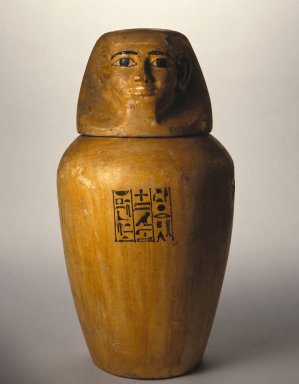canopic jar

Canopic jar of Lady Senebtisi.
A canopic jar is a covered vessel in which, in ancient Egypt, the embalmed viscera removed during mummification were placed for burial. After c.1000 BC the embalmed viscera were more generally replaced in the mummy and canopic jars rarely used.
In the Old Kingdom, embalmers frequently removed a corpse's stomach, liver, lungs, and intestines and placed them in special jars to be buried in a tomb with the deceased's mummy. Early Egyptologists called these vessels "canopic jars" as a reference to the mythical Greek sailor named Canopus who died in Egypt and was worshiped there in the form of a jar.
The practice of removing the organs and packing them separately declined in the Middle Kingdom. Instead, funerary workers often left them inside the mummy. Nevertheless, for reasons of magic or tradition, Middle Kingdom Egyptians still included canopic jars in most burials, Some jars contained mud and straw; others were left empty.
